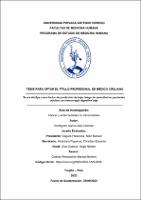Score sha2pe como factor de predicción de bajo riesgo de severidad en pacientes adultos con hemorragia digestiva baja
Resumen
Objetivo: Determinar si en pacientes adultos con hemorragia digestiva baja
el score sha2pe es un factor que predice el bajo riesgo de severidad.
Materiales y métodos: Se realizó un estudio observacional, transversal
analítico de pruebas diagnósticas, donde se evaluó a una muestra de 103
pacientes adultos con hemorragia digestiva baja que fueron atendidos en el
Hospital Regional Docente de Trujillo entre enero del 2016 y diciembre del
2019.
Resultados: La edad promedio en los grupos con y sin bajo riesgo de
severidad fueron 57,97 ± 19,47 vs 63,41 ± 20,59; el 60,61% y 58,57% de los
pacientes fueron varones en los grupos de estudio. La presión arterial
sistólica, la frecuencia cardiaca, el nivel de hemoglobina y el score Sha2pe
estuvieron asociados al bajo riesgo de severidad. Se obtuvieron valores de
sensibilidad: 81,82% IC 95% [65,61% - 91,39%], especificidad: 94,29% IC
95% [86,21% - 97,76%], valor Predictivo positivo: 87,10% IC 95% [71,15% -
94,87%], valor Predictivo negativo: 91,67% IC 95% [82,99% - 96,12%] y un
área bajo la curva del 0,904 en la predicción del riesgo de severidad por el
score Sha2pe en pacientes con hemorragia digestiva baja.
Conclusiones: El score Sha2pe tuvo un buen rendimiento en la predicción
de bajo riesgo de severidad de hemorragia digestiva baja Objective: To determine whether the sha2pe score is a predictor of low risk
of severity in adult patients with lower gastrointestinal bleeding.
Materials and methods: We conducted an observational, cross-sectional
analytical study of diagnostic tests, where we evaluated a sample of 103 adult
patients with lower gastrointestinal bleeding who were treated at the Hospital
Regional Docente de Trujillo between January 2016 and December 2019.
Results: The mean age in the groups with and without low severity risk were
57.97 ± 19.47 vs 63.41 ± 20.59; 60.61% and 58.57% of patients were male
in the study groups. Systolic blood pressure, heart rate, hemoglobin level and
Sha2pe score were associated with low risk of severity. Sensitivity values
were obtained: 81.82% CI 95% [65.61% - 91.39%], specificity: 94.29% CI
95% [86.21% - 97.76%], positive Predictive value: 87.10% CI 95% [71.15% -
94.87%], negative Predictive value: 91.67% CI 95% [82.99% - 96.12%] and
an area under the curve of 0.904 in the prediction of severity risk by Sha2pe
score in patients with lower GI bleeding.
Conclusions: The Sha2pe score performed well in predicting low risk of
severity of lower GI bleeding.
Palabras clave
Colecciones
- Medicina Humana [3196]


